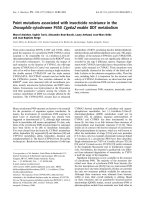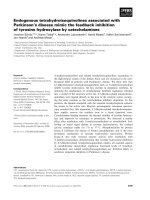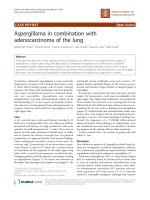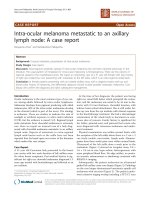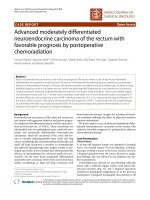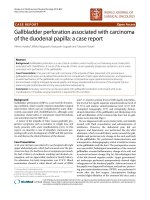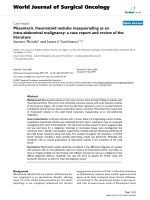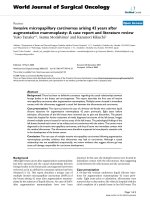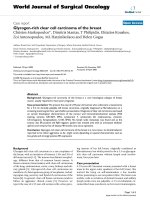Báo cáo khoa học: "Gallbladder perforation associated with carcinoma of the duodenal papilla: a case report" pdf
Bạn đang xem bản rút gọn của tài liệu. Xem và tải ngay bản đầy đủ của tài liệu tại đây (1.03 MB, 3 trang )
WORLD JOURNAL OF
SURGICAL ONCOLOGY
Hosaka et al. World Journal of Surgical Oncology 2010, 8:41
/>Open Access
CASE REPORT
© 2010 Hosaka et al; licensee BioMed Central Ltd. This is an Open Access article distributed under the terms of the Creative Commons
Attribution License ( which permits unrestricted use, distribution, and reproduction in
any medium, provided the original work is properly cited.
Case report
Gallbladder perforation associated with carcinoma
of the duodenal papilla: a case report
Akihiro Hosaka*, Mikiko Nagayoshi, Katsuyoshi Sugizaki and Yukiyoshi Masaki
Abstract
Background: Gallbladder perforation is a rare clinical condition, which mostly occurs following acute cholecystitis
associated with cholelithiasis. A tumor of the ampulla of Vater causes gradually progressive symptoms, and is rarely
associated with perforation of the gallbladder.
Case Presentation: A 56-year-old man with carcinoma of the ampulla of Vater presented with spontaneous
gallbladder perforation and localized bile peritonitis. He complained of right upper abdominal pain, and laparotomy
revealed perforation of the gallbladder with no gallstones. Postoperative upper gastrointestinal endoscopy
demonstrated a slightly enlarged duodenal papilla, and biopsy revealed adenocarcinoma of the ampulla. Pylorus-
preserving pancreaticoduodenectomy was performed subsequently.
Conclusion: Ampullary carcinoma can be associated with gallbladder perforation and present with acute
manifestations. Immediate surgical treatment is required for this condition.
Background
Gallbladder perforation (GBP) is a rare but life-threaten-
ing condition, which usually requires immediate surgical
intervention. Most cases are complicated by acute chole-
cystitis associated with cholelithiasis [1], although acute
acalculous cholecystitis or intramural vessel thrombosis
can sometimes lead to GBP [2,3].
A tumor of the ampulla of Vater causes gradually pro-
gressive symptoms such as jaundice or weight loss, and
rarely presents with acute manifestations [4-6]. In this
report, we describe a case of ampullary carcinoma pre-
senting with acute development of GBP and bile peritoni-
tis, and discuss the clinical features of the disease.
Case Presentation
A 56-year-old man was referred to our hospital with right
upper abdominal pain, which had worsened over the pre-
vious two days. He had been free of symptoms previously.
He had a history of moderate smoking and alcohol con-
sumption, and no appreciable medical or family history.
On admission, his body temperature was 37.4°C. Blood
examination showed a white blood cell count of 8900/
mm
3
, C-reactive protein level of 0.08 mg/dl, total biliru-
bin level of 0.6 mg/dl, aspartate aminotransferase level of
57 IU/l, and alanine aminotransferase level of 67 IU/l.
Computed tomography (CT) and echography demon-
strated distention of the gallbladder and thickening of its
wall and dilatation of the common bile duct, but no gall-
stones were detected (Fig 1).
He was diagnosed with acute cholecystitis, and initially
treated with fluid resuscitation and administration of
antibiotics. However, the abdominal pain did not
improve, and laparotomy was performed the day after
admission, which revealed biliary ascites around the gall-
bladder and partial necrotic change in the neck and body
of the gallbladder. We performed cholecystectomy and
intraoperative cholangiography, which revealed no stones
in the gallbladder and bile duct. The postoperative course
was uneventful. Pathological examination of the resected
gallbladder revealed inflammatory change of its wall, and
no arterial occlusive change (Fig 2a). Microbiological test
of the bile showed negative results. Upper gastrointesti-
nal endoscopy performed postoperatively showed slight
enlargement of the duodenal papilla. Adenocarcinoma of
the papilla was diagnosed by biopsy, and pylorus-preserv-
ing pancreaticoduodenectomy (PPPD) was performed 6
weeks after the first surgery. Intraoperative findings
revealed slight dilatation of the common bile duct, and a
* Correspondence:
1
Department of Surgery, Ome Municipal General Hospital, 16-5, Higashi Ome
4-chome, Ome-shi, Tokyo, 198-0042, Japan
Full list of author information is available at the end of the article
Hosaka et al. World Journal of Surgical Oncology 2010, 8:41
/>Page 2 of 3
soft pancreas with normal pancreatic duct. Pathological
examination of the resected specimens demonstrated
well-differentiated tubular adenocarcinoma with a maxi-
mum diameter of 1.3 cm localized in the papilla, with no
lymph node metastasis, classifying the tumor as TNM
stage IA (T1N0M0) (Fig 2b,c). Minor pancreatic leakage
occurred during the postoperative course, which was
treated conservatively. The patient has been free of recur-
rence during the 4-year follow-up after surgery.
Discussion
It has been reported that GBP occurs in about 5% of
patients with acute cholecystitis [1,7]. Ischemic changes
of the gallbladder wall triggered by progression of local
inflammation lead to gangrene and perforation, which
might explain why perforation occurs in the fundus, the
most distant part from the main feeding artery, in more
than half of cases. Systemic vascular disorders, such as
atherosclerotic cardiovascular disease and diabetes,
immunosuppressed states, and malignancy are major risk
factors for GBP [1]. Most cases of GBP follow an exacer-
bation of acute cholecystitis with cholelithiasis, and GBP
without gallstones is rare. Such cases are mainly attrib-
uted to impairment of the blood supply induced by intra-
mural thrombosis [3]. In our patient, who had no
underlying risk factor for GBP, no stones were found in
the gallbladder, and postoperative pathological examina-
tion revealed no thrombotic occlusion of intramural ves-
sels, which is extremely uncommon. The cause of GBP
remains unclear. It might have been induced by acute
progression of cholecystitis, although the causal relation-
ship between the ampullary tumor and GBP is not obvi-
ous.
Preoperative diagnosis of GBP is often difficult, which
delays surgical intervention and leads to high morbidity
and mortality [1,7]. CT and ultrasonography are useful in
making the diagnosis. Gallbladder wall thickening, peric-
holecystic fluid collection, and a streaky omentum or
mesentery are common findings of GBP [1,7-9]. However,
Figure 1 Preoperative imaging findings. Preoperative computed
tomography (a) and echography (b) show distention of the gallbladder
and thickening of its wall.
a
b
Figure 2 Pathological findings. Pathological examination of the
gallbladder revealed inflammatory change of its wall (a). The tumor of
the papilla was well-differentiated tubular adenocarcinoma with a
maximum diameter of 1.3 cm (b, c).
a
b
c
Hosaka et al. World Journal of Surgical Oncology 2010, 8:41
/>Page 3 of 3
accurate diagnosis of a defect in the gallbladder wall is
rather challenging. CT has been reported to be more sen-
sitive than ultrasonography in detecting a perforation site
in the gallbladder [1,8], while Sood et al. [9] reported that
a defect in the gallbladder wall could be visualized in
more than 70% of cases either by CT or ultrasonography,
and suggested the latter as the first-line imaging modality
in the evaluation of suspected GBP cases. In our patient,
the defect in the gallbladder wall and the amount of
leaked bile were small, which made preoperative diagno-
sis difficult.
Obstructive jaundice is the most common presentation
of carcinoma of the papilla, followed by weight loss,
abdominal pain, and nausea [4-6]. The disease usually
shows gradual progression of these symptoms, and rarely
displays an acute clinical onset. Associated GBP, as in our
patient, is extremely uncommon. The prognosis of amp-
ullary carcinoma is relatively better than that of other bil-
iary tract cancers after surgical resection [10]. Lymph
node metastasis and pancreatic invasion are important
prognostic factors [4,11]. Beger et al. [12] reported that
lymph node involvement was observed in about 10% of
patients with a pT1 carcinoma of the papilla. Therefore,
Kausch-Whipple procedure or PPPD with lymph node
dissection is the first choice of treatment even in patients
with localized cancer, although local resection might be
beneficial in patients with a poor general condition
[12,13].
Conclusion
Although extremely rare, carcinoma of the duodenal
papilla can be associated with GBP and display acute
manifestations. In a case of GBP without cholelithiasis,
ampullary tumor should be considered as a possible
underlying condition.
Consent
Written informed consent was obtained from the patient
for publication of this case report and accompanying
images. A copy of the written consent is available for
review by the Editor-in-Chief of this journal.
Competing interests
The authors declare that they have no competing interests.
Authors' contributions
AH participated in the treatment of the patient, collection of case details, litera-
ture search and drafted the manuscript. MN, KS, and YM participated in the
treatment of the patient and data collection, and helped to revise the manu-
script. All authors have read and approved the final manuscript.
Author Details
Department of Surgery, Ome Municipal General Hospital, 16-5, Higashi Ome 4-
chome, Ome-shi, Tokyo, 198-0042, Japan
References
1. Derici H, Kara C, Bozdag AD, Nazli O, Tansug T, Akca E: Diagnosis and
treatment of gallbladder perforation. World J Gastroenterol 2006,
12:7832-6.
2. Wang AJ, Wang TE, Lin CC, Lin SC, Shih SC: Clinical predictors of severe
gallbladder complications in acute acalculous cholecystitis. World J
Gastroenterol 2003, 9:2821-3.
3. Namikawa T, Kobayashi M, Okabayashi T, Okamoto K, Akimori T, Sugimoto
T, Hanazaki K: Clinicopathological analysis of idiopathic perforation of
the gallbladder. Surg Today 2007, 37:633-7.
4. Beger HG, Treitschke F, Gansauge F, Harada N, Hiki N, Mattfeldt T: Tumor
of the ampulla of Vater: experience with local or radical resection in
171 consecutively treated patients. Arch Surg 1999, 134:526-32.
5. Madjov R, Chervenkov P: Carcinoma of the papilla of Vater. Diagnostic
and surgical problems. Hepatogastroenterology 2003, 50:621-4.
6. Kamisawa T, Tu Y, Egawa N, Nakajima H, Horiguchi S, Tsuruta K, Okamoto
A: Clinicopathologic features of ampullary carcinoma without
jaundice. J Clin Gastroenterol 2006, 40:162-6.
7. Menakuru SR, Kaman L, Behera A, Singh R, Katariya RN: Current
management of gall bladder perforations. ANZ J Surg 2004, 74:843-6.
8. Kim PN, Lee KS, Kim IY, Bae WK, Lee BH: Gallbladder perforation:
comparison of US findings with CT. Abdom Imaging 1994, 19:239-42.
9. Sood BP, Kalra N, Gupta S, Sidhu R, Gulati M, Khandelwal N, Suri S: Role of
sonography in the diagnosis of gallbladder perforation. J Clin
Ultrasound 2002, 30:270-4.
10. Ishihara S, Miyakawa S, Takada T, Takasaki K, Nimura Y, Tanaka M, Miyazaki
M, Nagakawa T, Kayahara M, Horiguchi A: Status of surgical treatment of
biliary tract cancer. Dig Surg 2007, 24:131-6.
11. Moriya T, Kimura W, Hirai I, Mizutani M, Ma J, Kamiga M, Fuse A: Nodal
involvement as an indicator of postoperative liver metastasis in
carcinoma of the papilla of Vater. J Hepatobiliary Pancreat Surg 2006,
13:549-55.
12. Beger HG, Thorab FC, Liu Z, Harada N, Rau BM: Pathogenesis and
treatment of neoplastic diseases of the papilla of Vater: Kausch-
Whipple procedure with lymph node dissection in cancer of the
papilla of Vater. J Hepatobiliary Pancreat Surg 2004, 11:232-8.
13. Kobayashi A, Konishi M, Nakagohri T, Takahashi S, Kinoshita T: Therapeutic
approach to tumors of the ampulla of Vater. Am J Surg 2006, 192:161-4.
doi: 10.1186/1477-7819-8-41
Cite this article as: Hosaka et al., Gallbladder perforation associated with
carcinoma of the duodenal papilla: a case report World Journal of Surgical
Oncology 2010, 8:41
Received: 18 February 2010 Accepted: 20 May 2010
Published: 20 May 2010
This article is available from: 2010 Ho saka et al; l icensee Bio Med Central Ltd. This is an Open Access article distributed under the terms of the Creative Commons Attribution License ( ), which permits unrestricted use, distribution, and reproduction in any medium, provided the original work is properly cited.World Journal of Surgical Oncology 2010, 8:41
